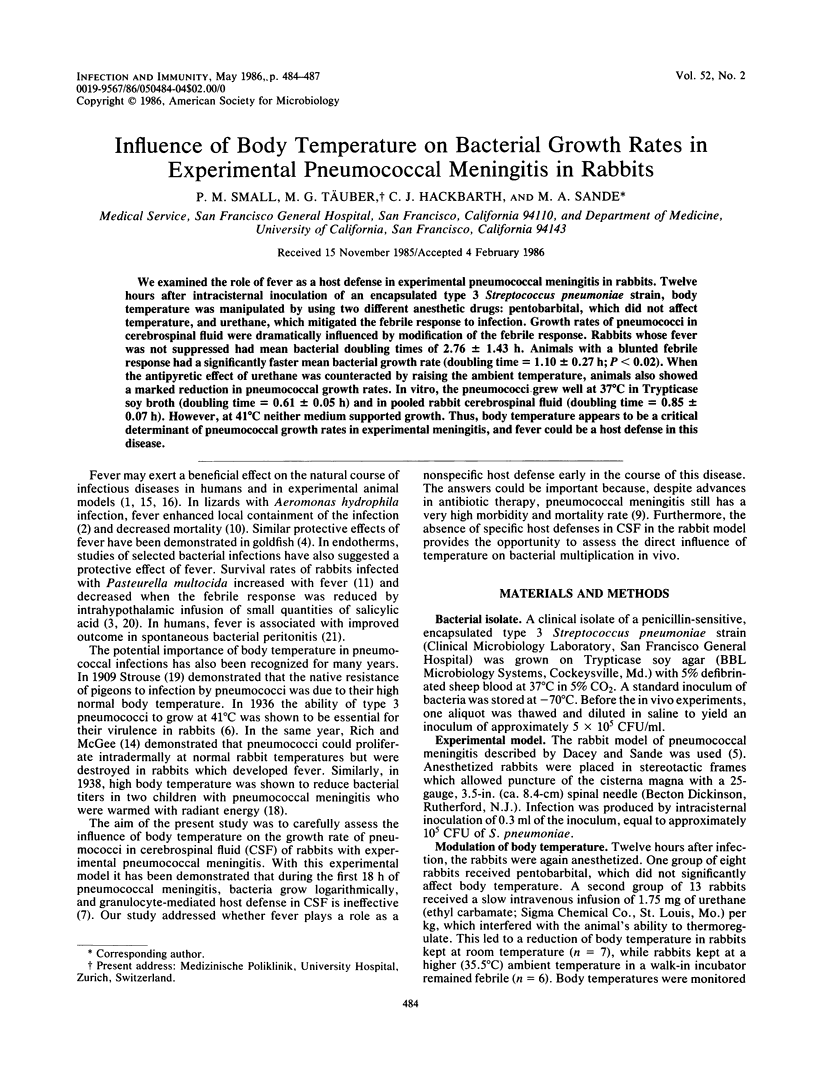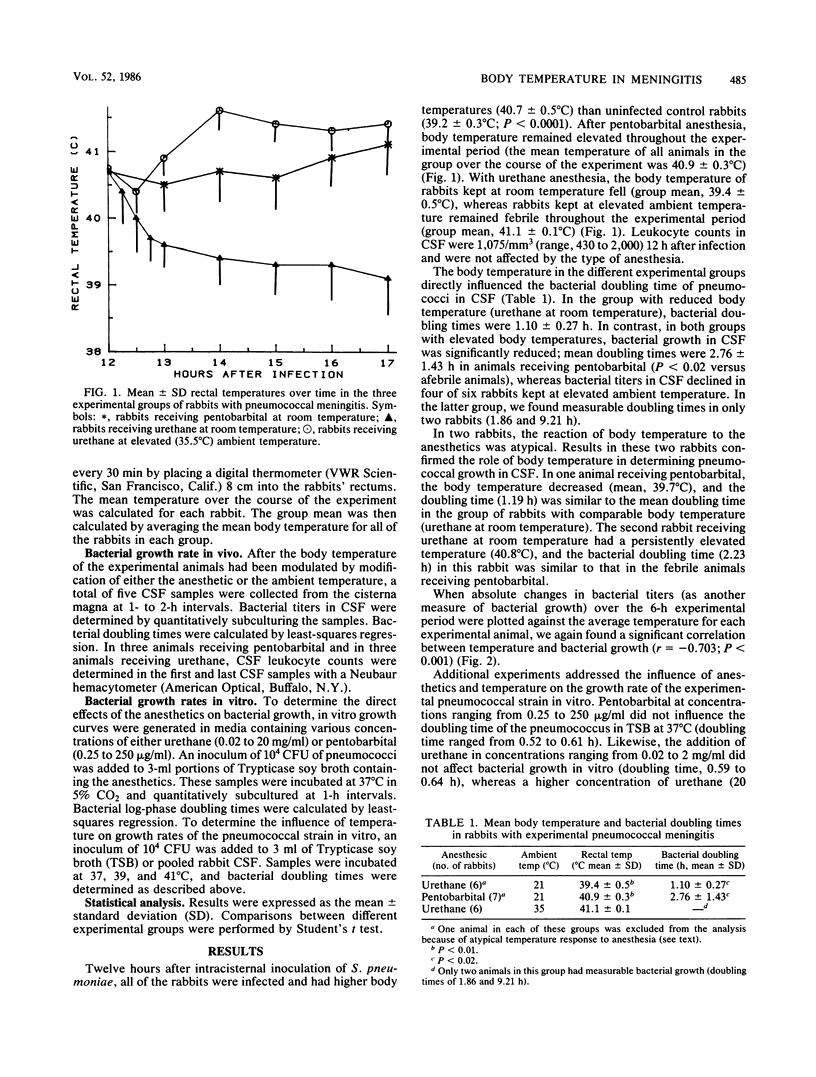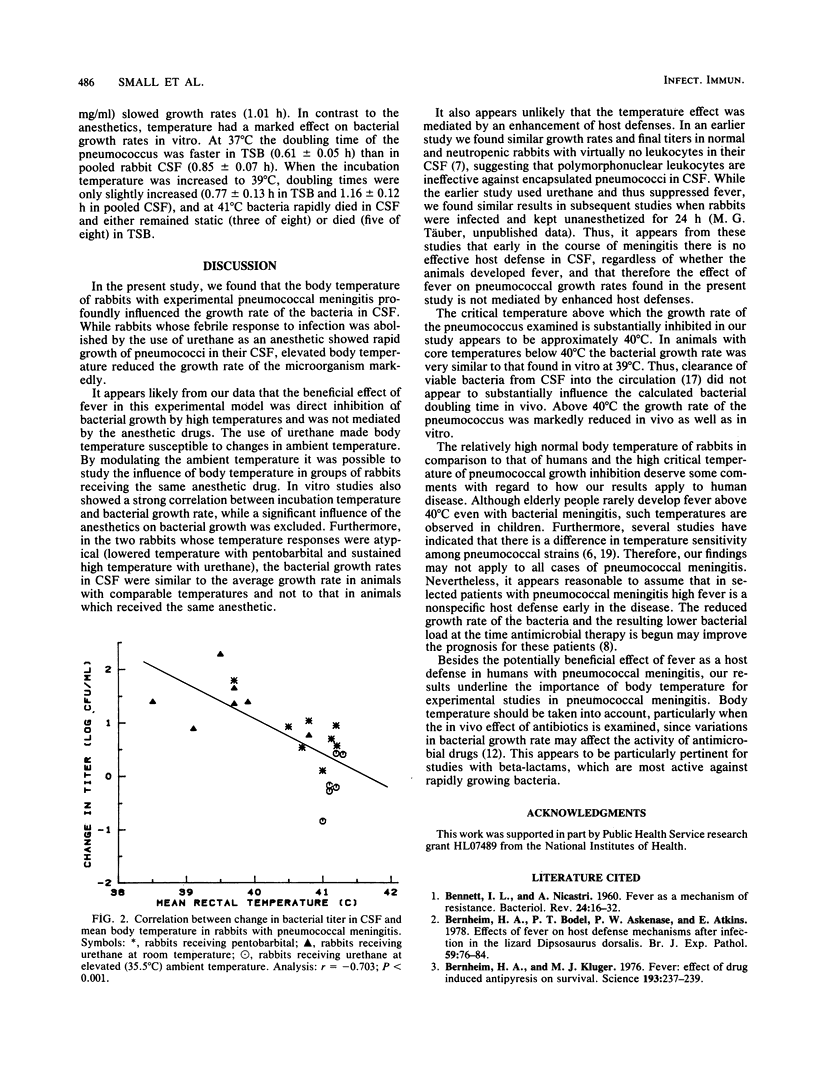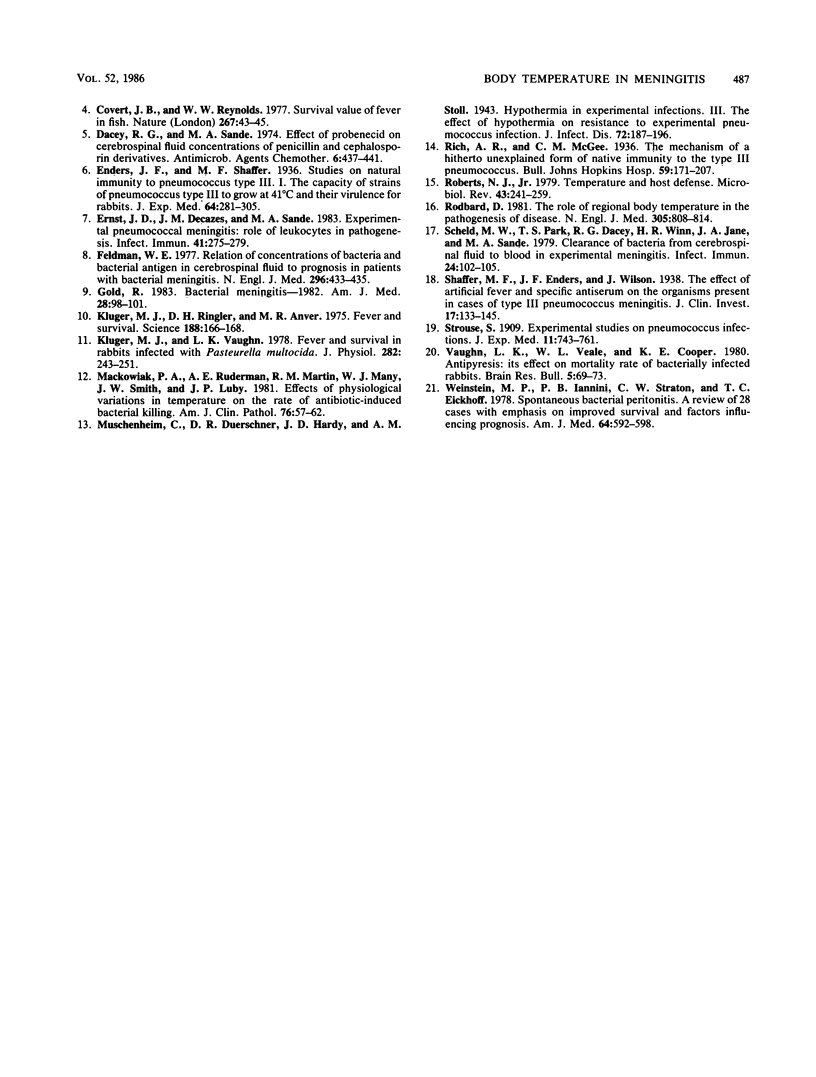Abstract
We examined the role of fever as a host defense in experimental pneumococcal meningitis in rabbits. Twelve hours after intracisternal inoculation of an encapsulated type 3 Streptococcus pneumoniae strain, body temperature was manipulated by using two different anesthetic drugs: pentobarbital, which did not affect temperature, and urethane, which mitigated the febrile response to infection. Growth rates of pneumococci in cerebrospinal fluid were dramatically influenced by modification of the febrile response. Rabbits whose fever was not suppressed had mean bacterial doubling times of 2.76 +/- 1.43 h. Animals with a blunted febrile response had a significantly faster mean bacterial growth rate (doubling time = 1.10 +/- 0.27 h; P less than 0.02). When the antipyretic effect of urethane was counteracted by raising the ambient temperature, animals also showed a marked reduction in pneumococcal growth rates. In vitro, the pneumococci grew well at 37 degrees C in Trypticase soy broth (doubling time = 0.61 +/- 0.05 h) and in pooled rabbit cerebrospinal fluid (doubling time = 0.85 +/- 0.07 h). However, at 41 degrees C neither medium supported growth. Thus, body temperature appears to be a critical determinant of pneumococcal growth rates in experimental meningitis, and fever could be a host defense in this disease.
Full text
PDF



Selected References
These references are in PubMed. This may not be the complete list of references from this article.
- BENNETT I. L., Jr, NICASTRI A. Fever as a mechanism of resistance. Bacteriol Rev. 1960 Mar;24(1):16–34. doi: 10.1128/br.24.1.16-34.1960. [DOI] [PMC free article] [PubMed] [Google Scholar]
- Bernheim H. A., Bodel P. T., Askenase P. W., Atkins E. Effects of fever on host defense mechanisms after infection in the lizard Dipsosaurus dorsalis. Br J Exp Pathol. 1978 Feb;59(1):76–84. [PMC free article] [PubMed] [Google Scholar]
- Bernheim H. A., Kluger M. J. Fever: effect of drug-induced antipyresis on survival. Science. 1976 Jul 16;193(4249):237–239. doi: 10.1126/science.935867. [DOI] [PubMed] [Google Scholar]
- Covert J. B., Reynolds W. W. Survival value of fever in fish. Nature. 1977 May 5;267(5606):43–45. doi: 10.1038/267043a0. [DOI] [PubMed] [Google Scholar]
- Dacey R. G., Sande M. A. Effect of probenecid on cerebrospinal fluid concentrations of penicillin and cephalosporin derivatives. Antimicrob Agents Chemother. 1974 Oct;6(4):437–441. doi: 10.1128/aac.6.4.437. [DOI] [PMC free article] [PubMed] [Google Scholar]
- Ernst J. D., Decazes J. M., Sande M. A. Experimental pneumococcal meningitis: role of leukocytes in pathogenesis. Infect Immun. 1983 Jul;41(1):275–279. doi: 10.1128/iai.41.1.275-279.1983. [DOI] [PMC free article] [PubMed] [Google Scholar]
- Feldman W. E. Relation of concentrations of bacteria and bacterial antigen in cerebrospinal fluid to prognosis in patients with bacterial meningitis. N Engl J Med. 1977 Feb 24;296(8):433–435. doi: 10.1056/NEJM197702242960806. [DOI] [PubMed] [Google Scholar]
- Gold R. Bacterial meningitis--1982. Am J Med. 1983 Jul 28;75(1B):98–101. doi: 10.1016/0002-9343(83)90079-7. [DOI] [PubMed] [Google Scholar]
- Kluger M. J., Ringler D. H., Anver M. R. Fever and survival. Science. 1975 Apr 11;188(4184):166–168. [PubMed] [Google Scholar]
- Kluger M. J., Vaughn L. K. Fever and survival in rabbits infected with Pasteurella multocida. J Physiol. 1978 Sep;282:243–251. doi: 10.1113/jphysiol.1978.sp012460. [DOI] [PMC free article] [PubMed] [Google Scholar]
- Mackowiak P. A., Ruderman A. E., Martin R. M., Many W. J., Smith J. W., Luby J. P. Effects of physiologic variations in temperature on the rate of antibiotic-induced bacterial killing. Am J Clin Pathol. 1981 Jul;76(1):57–62. doi: 10.1093/ajcp/76.1.57. [DOI] [PubMed] [Google Scholar]
- Roberts N. J., Jr Temperature and host defense. Microbiol Rev. 1979 Jun;43(2):241–259. doi: 10.1128/mr.43.2.241-259.1979. [DOI] [PMC free article] [PubMed] [Google Scholar]
- Rodbard D. The role of regional body temperature in the pathogenesis of disease. N Engl J Med. 1981 Oct 1;305(14):808–814. doi: 10.1056/NEJM198110013051406. [DOI] [PubMed] [Google Scholar]
- Scheld W. M., Park T. S., Dacey R. G., Winn H. R., Jane J. A., Sande M. A. Clearance of bacteria from cerebrospinal fluid to blood in experimental meningitis. Infect Immun. 1979 Apr;24(1):102–105. doi: 10.1128/iai.24.1.102-105.1979. [DOI] [PMC free article] [PubMed] [Google Scholar]
- Shaffer M. F., Enders J. F., Wilson J. THE EFFECT OF ARTIFICIAL FEVER AND SPECIFIC ANTISERUM ON THE ORGANISMS PRESENT IN CASES OF TYPE III PNEUMOCOCCUS MENINGITIS. J Clin Invest. 1938 Mar;17(2):133–145. doi: 10.1172/JCI100936. [DOI] [PMC free article] [PubMed] [Google Scholar]
- Vaughn L. K., Veale W. L., Cooper K. E. Antipyresis: its effect on mortality rate of bacterially infected rabbits. Brain Res Bull. 1980 Jan-Feb;5(1):69–73. doi: 10.1016/0361-9230(80)90285-3. [DOI] [PubMed] [Google Scholar]
- Weinstein M. P., Iannini P. B., Stratton C. W., Eickhoff T. C. Spontaneous bacterial peritonitis. A review of 28 cases with emphasis on improved survival and factors influencing prognosis. Am J Med. 1978 Apr;64(4):592–598. doi: 10.1016/0002-9343(78)90578-8. [DOI] [PubMed] [Google Scholar]


